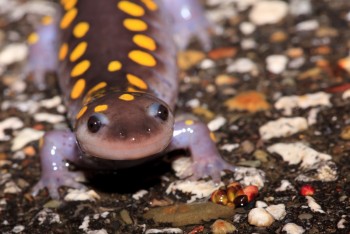On Warm, Rainy Nights in Spring ...
Posted 03/14/25
“Great Undulating Amphibians, Batman,” Robin cried in distress, “How will we ever help all these little salamanders safely across the road.”
“Fear not Robin. This is the Big Night in Maine. Kind hearts and courageous souls from all quarters will join us in helping our beautiful neighbors, the wood frogs, spotted salamanders, little red efts, spring peepers, and all their cousins, to make a safe passage over that forbidding span of tar, nemesis of all wildlife, THE STREET. This is a fatal undertaking for so many of our waning population of amphibians. Quickly, Robin, don your florescent yellow vest and headlamp and into the Big Night we go.”
The Big Night. During the first warm and rainy nights of early spring, perhaps mid-April,(or earlier) with a temperature of 45 degrees(F) or more, thousands of amphibians throughout the State of Maine will be venturing out of their winter hibernation retreats and migrating to vernal ponds, seasonal wetlands, swamps, and roadside ditches, those trenches being yet another danger to the species where the heavy concentration of road-salt collects causing great damage to amphibian reproductive cycles. They travel under cover of night and rain to avoid getting too dried out, and again, another hazard is met: Unfortunately, they are very hard for an automobile operator to see due to limited visibility, their small size, and the black shadowing of Maine’s deep wood forests over the country roads. So, people dedicated to the preservation of the progeny our amphibious forbears wash their hands of all salts, commercial oils, fragrances, and Cheeto-dust, rub them in grass, moss, and dirt, then, take to the streets and start to gently assist the little guys and gals across the street in their preferred direction of travel.
Last year, 2024, over 30,000 amphibians were recorded by Maine Big Night workers; citizen scientists, real, in-the-flesh, scientists, and, by and large, mostly just people, young and old, firm and not quite so, avid or casual, lovers of frogs, toads, salamanders and newts all. The heartbreak of this census was that 24%, almost a full quarter, of these amphibians were found as roadkill and beyond help, even though the information they contributed through their demise was still valuable given what little we know about such an amazing array of creatures which are disappearing from this planet at a heart-rending rate: loss of habitat, environmental pollutants, climate change...You know the lineup. Not long ago another species of white rhinoceros died off and it was like a punch in the gut. The loss of any species hurts, but the amphibians are an entire class of wildlife that now are in existential crisis. And, unlike the wild rhino or our own wondrous whales whom we can only help from afar, these salamanders we can help, one at a time, cross the road...But I shall not dwell on the tragic.
There is a job to be done. Amphibians need help. Now. Without these slimy little creatures, just think— BUGS. Lots, and lots, and lots more of bugs. I once had a ring-side seat to a toad eating moths at a campsite candle. The toad nabbed them on the end of his tongue and ate over a dozen in as many minutes (of course, he/she shucked off the wings, them being far too rangy and not worth taking up valuable belly space). The best thing you can do is contact MBN, Maine Big Night, check out the specs and see if you can contribute in any way to their concerted efforts to help the amphibians of Maine thrive and flourish. And, if you cannot engage in the Big Night activities, please stay home or limit your driving on the warm and wet nights of early spring and take great caution for the salamanders and their human crossing-guards as they make their way through the night.
Contact: Maine Big Night
by: CA Kniffen

